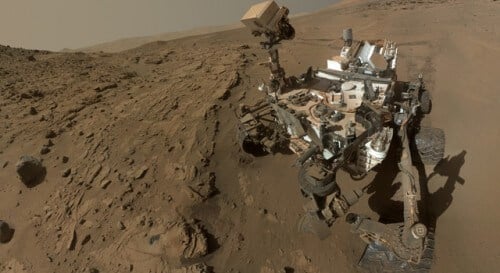During the 687 days that have passed since his landing, he is responsible for the discovery that in the past water flowed in the landing area, and at least the conditions for bacterial life existed

The Mars rover Curiosity marked this week (June 24) the first complete Martian year of 687 days for Earth, and achieved the main goal of the mission - to determine whether favorable environmental conditions for bacterial life prevailed on Mars.
One of Curiosity's first important findings after landing on the Red Planet in August 2012 was an ancient stream channel at the landing site. Near it, in the area known as 'Yellow Knife Bay', the mission scientists achieved their goal - to determine whether Gale Crater ever hosted simple life forms. The historical "yes" answer came from two lumps of fossilized mud that the vehicle discovered through its excavation array. Analysis of these samples revealed that the area was once the bottom of a lake that contained water at moderate temperatures, the essential ingredient for life, as well as a type of chemical energy used by some bacteria on Earth. If living beings lived on Mars it would be a good home for them.
Other important findings discovered by Curiosity in its first Martian year:
An assessment of the natural radiation levels during the flight to Mars and on the surface of Mars, which will provide a guide for designing the protection required for a manned mission to Mars.
The measurement of the diversity in the isotopes of the elements in the Martian atmosphere, which indicates that most of the ancient atmosphere of Mars was absorbed into space, and first it was the light atoms at the edge of the atmosphere that escaped. Other measurements have revealed that there is very little, if any, methane in the atmosphere. This gas is important because it is mainly produced in living processes.
The first determination of the age of a Madimai rock and how long it was exposed to the dangerous radiation. This is in order to determine the erosion rate of the organic materials in the rocks and soil.
Curiosity has so far covered about 8 kilometers from the landing site and is on its way to Mount Sharp, a high mountain located in the center of Gale Crater. The entry point to the mountain is through a gap in the dune strip bordering the northern area of the mountain which is now approximately 3.9 kilometers from the vehicle's current location. The new route will cause Curiosity to cross sandy soils and rocks. Before it reaches them, NASA's MRO spacecraft will map the area for the mission planners so they can choose the safest path.

4 תגובות
For those who are interested, it is possible to register on NASA's YouTube website
and receive updates on the project from the technical team involved in this impressive project.
This is the link for a year's coverage of the robot on Mars.
https://www.youtube.com/watch?v=SSf1HenQhWs&list=UUryGec9PdUCLjpJW2mgCuLw
Very interesting article